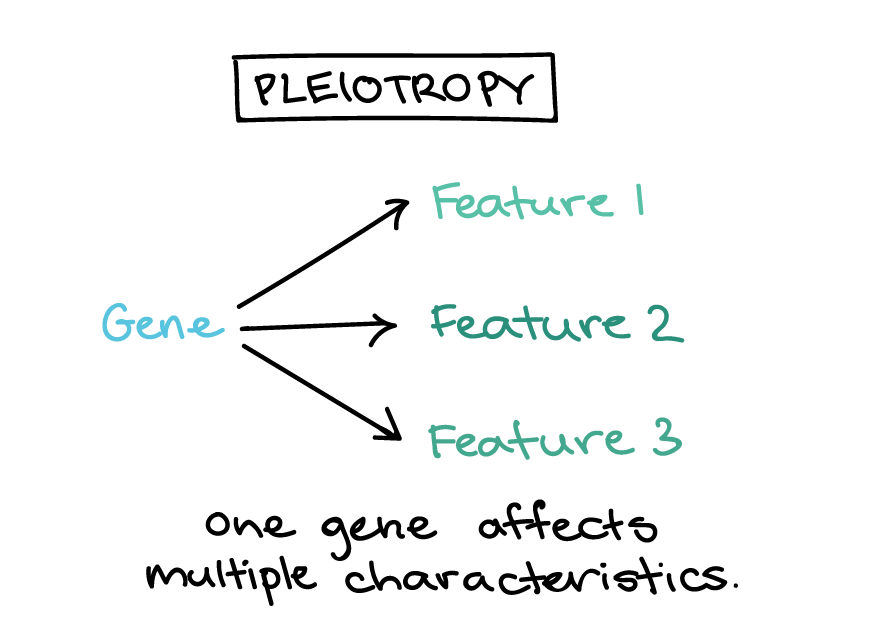Learning Outcomes
- Explain pleiotropy and its impact on traits in a population
Based on Mendel’s experiments, you might imagine that all genes control a single characteristic, are present in two copies, and affect some harmless aspect of an organism’s appearance (such as color, height, or shape). Although those predictions are accurate in many cases, there are also some important exceptions. For instance, how can we explain observations like the following?
- The genetic disorder Marfan syndrome is caused by a mutation in one gene, yet it affects many aspects of growth and development, including height, vision, and heart function.
To understand observations like these, we need to look more deeply at what genes are. Rather than abstract “heritable factors,” genes are stretches of DNA found on chromosomes, and most of them encode (specify the sequence of) proteins that do a certain job in the cell or body. In this article, we’ll look in more detail at genes affecting multiple characteristics (pleiotropy).
Pleiotropy
When we discussed Mendel’s experiments with purple-flowered and white-flowered plants, we didn’t mention any other phenotypes associated with the two flower colors. However, Mendel noticed that the flower colors were always correlated with two other features: the color of the seed coat (covering of the seed) and the color of the axils (junctions where the leaves met the main stem)[1]. In plants with white flowers, the seed coats and axils were colorless, while in plants with purple flowers, the seed coats were brown-gray and the axils were reddish. Thus, rather than affecting just one characteristic, the flower color gene actually affected three.

Based on similar diagram by Ingrid Lobo
Genes like this, which affect multiple, seemingly unrelated aspects of an organism’s phenotype, are said to be pleiotropic (pleio– = many, –tropic = effects)[2]. We now know that Mendel’s flower color gene encodes a regulator protein that activates pigment biosynthesis, and that it works in several different parts of the pea plant (flowers, seed coat, and leaf axils). Thus, the seemingly unrelated phenotypes can all be traced back to a defect in a single gene with several jobs.
Alleles of pleiotropic genes are transmitted in the same way as alleles of genes that affect single traits. In these cases, the difference is that the phenotype contains multiple elements. These elements are specified as a package, and there would be both a dominant and recessive version of this package of traits.
Pleiotropy in Human Genetic Disorders
Genes affected in human genetic disorders are often pleiotropic. For example, people with the hereditary disorder Marfan syndrome may have a constellation of seemingly unrelated symptoms[3]:
- Unusually tall height
- Thin fingers and toes
- Dislocation of the lens of the eye
- Heart problems (in which the aorta, the large blood vessel carrying blood away from the heart, bulges or ruptures).
These symptoms don’t appear directly related to one another, but as it turns out, they can all be traced back to the mutation of a single gene. This gene encodes a protein that assembles into chains, making elastic fibrils that give strength and flexibility to the body’s connective tissues[4]. Disease-causing mutations in the Marfan syndrome reduce the amount of functional protein produced, resulting in fewer fibrils. The eye and the aorta normally contain many fibrils that help maintain structure, explaining why these two organs are strongly affected in Marfan syndrome[5]. In addition, the fibrils serve as “storage shelves” for growth factors. When there are fewer of them in Marfan syndrome, the growth factors cannot be shelved and thus cause excess growth (leading to the characteristic tall, thin Marfan build)[6].
Try It
Contribute!
- Lobo, I. (2008). Pleiotropy: One gene can affect multiple traits. Nature Education, 1(1), 10. Retrieved from http://www.nature.com/scitable/topicpage/pleiotropy-one-gene-can-affect-multiple-traits-569. ↵
- Ibid. ↵
- Marfan syndrome. (2012). In Genetics home reference. Retrieved from http://ghr.nlm.nih.gov/condition/marfan-syndrome. ↵
- FBN1. (2015). In Genetics home reference. Retrieved from http://ghr.nlm.nih.gov/gene/FBN1. ↵
- Marfan syndrome. (2015, November 3). Retrieved November 21, 2015 from Wikipedia: https://en.wikipedia.org/wiki/Marfan_syndrome. ↵
- FBN1. (2015). In Genetics home reference. Retrieved from http://ghr.nlm.nih.gov/gene/FBN1. ↵
